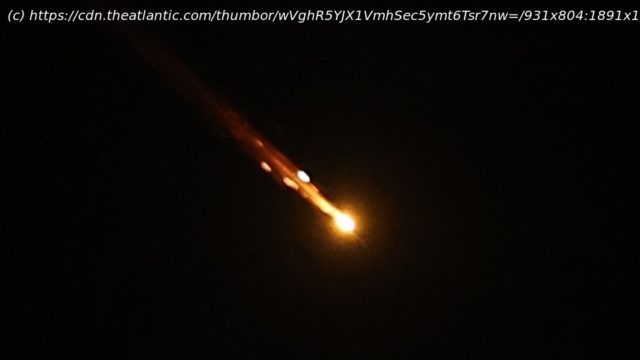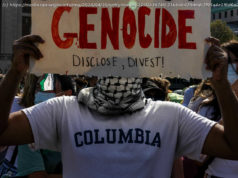To understand what we are observing, we have to push out beyond the frame of what we at first see.
My wife the photo archivist likes to point out that all stills are a double crop—a crop in time (we do not know what happened before or after) and a crop in place (we do not know what was outside the photographer’s frame). So, too, are pulses of violence, like Iran’s recent salvo of 300 drones, cruise, and ballistic missiles aimed at Israel. To understand what we are observing, we have to push out beyond the frame of what we at first see.
The attack last night was not a mere response to the Israeli strike in Damascus on April 1 that killed two Iranian generals and five other officers in the Revolutionary Guard Corps. Rather, it represents an inflection point in a semi-covert war that has been going on for years. That conflict has included attacks on shipping by both sides, the bombing of Jewish and Israeli civilian targets, the launch of rockets across Israel’s northern border, and the occasional assassination of key figures, such as Mohsen Fakhrizadeh, the godfather of the Iranian nuclear program.
Israel’s sardonic war humorists have been cracking jokes about the first direct flight from Tehran to Jerusalem since 1979, but as tends to happen, the joke has a kernel of insight: Unflinching hostility toward Israel is part of the Islamic Republic’s DNA. That hostility, moreover, is inextricably linked to its hostility toward the United States: One is the lesser Satan, the other the great. Reconciliation with either is ideologically impossible; hostility toward both, and the belief that the two are intertwined, is unshakeable.
But there is a departure here. Iran’s semi-covert war has used Hezbollah in Lebanon (and elsewhere in the world), Iraqi militias, and Yemen’s Houthis to attack and kill its enemies. That inhibition has begun to dissolve. Firing more than 300 guided weapons, and claiming responsibility for doing so, is an overt declaration that Iran is willing to wage war in the sunlight and not just the shadows.
This, in turn, is part of a larger pattern of Iranian belligerence: It includes the use of Iraqi militias to attack American bases, and the arming and assistance of Houthi militias in their attacks on civilian shipping in the Red Sea and beyond. It forces the question: Why has Iran begun to act more blatantly, less cautiously, and at greater ranges than ever before?
One answer may be the seemingly irrevocable march of that country to the possession of nuclear weapons, a march that was briefly slowed by the American invasion of Iraq in 2003 (which was followed by a pause in the Iranian program) and the ill-fated and time-limited Joint Comprehensive Plan of Action (JCPOA) negotiated in 2015, abandoned by the Trump administration and unsuccessfully attempted to be revived by the Biden administration.






